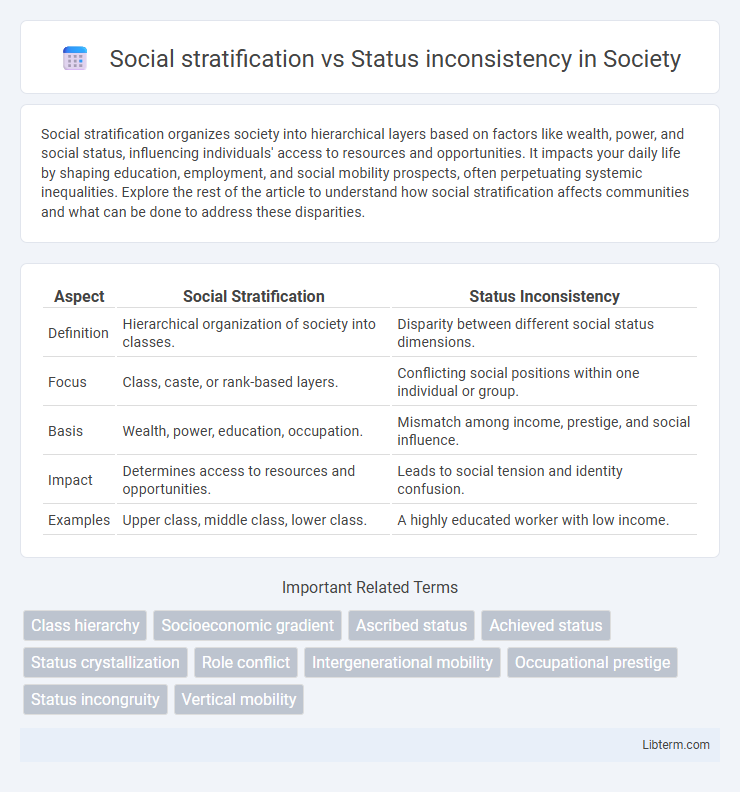Social stratification organizes society into hierarchical layers based on factors like wealth, power, and social status, influencing individuals' access to resources and opportunities. It impacts your daily life by shaping education, employment, and social mobility prospects, often perpetuating systemic inequalities. Explore the rest of the article to understand how social stratification affects communities and what can be done to address these disparities.
Table of Comparison
| Aspect | Social Stratification | Status Inconsistency |
|---|---|---|
| Definition | Hierarchical organization of society into classes. | Disparity between different social status dimensions. |
| Focus | Class, caste, or rank-based layers. | Conflicting social positions within one individual or group. |
| Basis | Wealth, power, education, occupation. | Mismatch among income, prestige, and social influence. |
| Impact | Determines access to resources and opportunities. | Leads to social tension and identity confusion. |
| Examples | Upper class, middle class, lower class. | A highly educated worker with low income. |
Understanding Social Stratification: Key Concepts
Social stratification refers to the hierarchical arrangement of individuals in society based on factors like wealth, power, and prestige, creating structured social layers. Status inconsistency occurs when an individual's social positions have differing levels of prestige or influence, leading to conflicting social expectations. Understanding these concepts highlights how social inequalities persist and affect individual experiences within various social hierarchies.
Defining Status Inconsistency in Sociology
Status inconsistency in sociology refers to a situation where an individual holds differing levels of status across various social dimensions, such as wealth, education, and occupation, leading to conflicting social positions. This contrasts with social stratification, which denotes a structured hierarchy based on consistent rankings within society, typically determined by class, caste, or power. Understanding status inconsistency highlights how individuals can experience social tension or instability when their social prestige does not align across multiple status indicators.
Historical Perspectives on Social Hierarchies
Historical perspectives on social hierarchies reveal that social stratification involves fixed layers of society based on economic, occupational, and power differences, while status inconsistency occurs when an individual's social positions have conflicting rankings in different dimensions such as wealth, education, or prestige. Classic sociologists like Max Weber emphasized that social stratification encompasses class, status, and party, highlighting how these dimensions interact but can also lead to status inconsistency in complex modern societies. Studies of caste systems and feudal societies illustrate rigid stratification, whereas emerging industrial societies exhibit more frequent status inconsistencies as social mobility and role complexity increase.
Dimensions of Social Stratification: Class, Race, and Gender
Social stratification encompasses hierarchical divisions in society primarily based on class, race, and gender, which collectively shape individuals' access to resources, power, and opportunities. Status inconsistency occurs when an individual's social positions across these dimensions conflict, such as possessing high economic capital but low social prestige or racial discrimination. Understanding the interplay between class, race, and gender elucidates the complexities of social inequality and highlights how status inconsistency challenges traditional stratification systems.
Causes and Examples of Status Inconsistency
Status inconsistency arises when an individual holds differing levels of social prestige, income, or occupational status, creating conflicting social positions that challenge conventional social hierarchies. Causes of status inconsistency often include educational attainment that exceeds job rank, high income paired with low occupational prestige, or influential community roles combined with limited economic resources. Examples include a highly educated artist earning low income, a wealthy business owner with little formal education, or a respected community leader working in a low-status profession.
Social Stratification vs. Status Inconsistency: Core Differences
Social stratification refers to the hierarchical arrangement of individuals or groups in a society based on factors such as wealth, power, and prestige, creating structured social layers. Status inconsistency occurs when an individual's social positions have conflicting levels of prestige or power, such as high education but low income, leading to social tension and ambiguity in social standing. The core difference lies in social stratification focusing on the overall societal ranking system, while status inconsistency highlights the contradictory social status an individual may experience within that system.
Effects of Status Inconsistency on Individual Identity
Status inconsistency occurs when an individual's social positions hold conflicting levels of prestige, wealth, or power, leading to psychological stress and social confusion. This disparity affects individual identity by causing feelings of frustration, lowered self-esteem, and challenges in social interactions due to ambiguous societal expectations. The resulting identity conflict can influence behavior, social mobility, and overall well-being as individuals navigate contradictory status signals.
The Impact of Stratification on Life Chances
Social stratification shapes life chances by creating structured inequalities in access to resources such as education, healthcare, and employment opportunities, often determining an individual's socioeconomic mobility. Status inconsistency occurs when an individual's social positions have conflicting ranks, such as high education but low income, which can negatively affect social identity and access to resources. The impact of stratification on life chances is profound, as it reinforces barriers that limit upward mobility and perpetuate unequal outcomes across different social groups.
Coping Mechanisms for Status Inconsistency
Coping mechanisms for status inconsistency involve reconciling conflicting social positions by emphasizing certain roles or identities to maintain self-esteem and social acceptance. Individuals may adopt strategies such as role distancing, selective social interaction, or re-evaluating personal values to reduce psychological stress caused by mismatched status elements like income, education, or occupation. These adaptive responses help mitigate the negative effects of status inconsistency by creating a more coherent social identity despite structural disparities.
Addressing Inequality: Policy and Social Change
Social stratification structures societies into hierarchical layers based on factors like wealth, power, and prestige, while status inconsistency occurs when an individual's social positions across these dimensions conflict, leading to tension and inequality. Policies targeting social inequality must consider both systemic stratification mechanisms and the complexities of status inconsistency to effectively promote social mobility and reduce disparities. Comprehensive social change involves addressing economic disparities, educational access, and occupational prestige simultaneously to create a more equitable society.
Social stratification Infographic

 libterm.com
libterm.com